You wrote it years ago. It did well at the time.
People liked it …it was opened and clicked.
Google liked it …it was indexed and ranked.
But readers and search engines moved on. And you never looked back. But maybe it’s time to update that old blog post. Maybe if you freshen it up, it would do well in inboxes and social streams. And maybe it would appear again in search results. For many bloggers, this works.
The bloggers who update old articles are twice as likely to report “strong results” from content marketing.
That’s according to our annual blogger survey. Since 2017 we’ve asked the question “Is it part of your strategy to update old articles?” Every year, more bloggers answer yes. And that answer has a huge correlation with results.
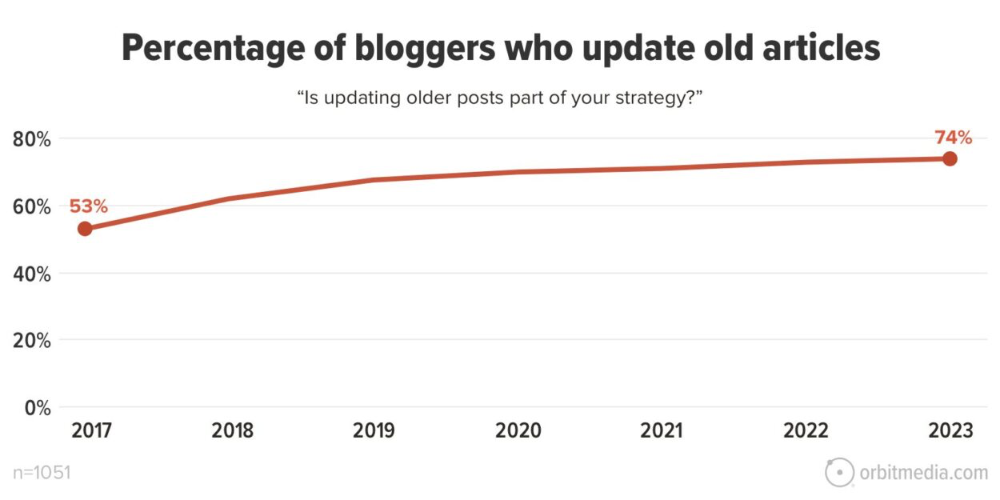
Why is it so effective to update old blog posts?
There are at least five reasons to update an old post, rather than write something new:
- The topic has been vetted because you saw that it worked well the first time
- It’s faster to make because some of the writing and research is already done
- It’s higher quality because the updated article expands on the topic
- It’s easier to promote in social media because you’ll know just who to share it with
- It’s better for SEO because the URL is already indexed and possibly links
In other words, you’ll get better results with less effort.
Here is our guide for updating content. We’ll show you which posts to revisit, how to update them and finally how to promote updated content. By the time you get to the examples below, it will already be obvious just how effective this content strategy can be.
 |
Brian Dean, Exploding Topics“If all of my content is up-to-date and ranking where I think it should be, I’ll write something new. If not, I’ll update and relaunch an old post.” |
Which of your old blog posts should you update?
You’ve published 100+ published articles over the years. Or you’ve taken over a website with a lot of legacy content. Some of these past articles already have 10x more value than the rest. Others are good but not yet great. Which ones should you update?
The goal is to push more articles into that 10x results category. Some articles have the best opportunities to become big winners, with SEO and with visitors. Here’s what we’re looking for:
- Articles that almost rank high. They could become traffic magnets with a little boost.
- Articles that are already high ranking traffic magnets, but at risk of being surpassed by rivals.
- Articles that created a lot of buzz when they were first published
- Research articles that have gone out of date
Two of these are specific SEO opportunities, easily discoverable through our GA4-powered content marketing audit.
 |
Erin Balsa, Haus of Bold“Start by doing a content audit. This will help you prioritize which pieces of content to update and optimize vs. which to leave alone, redirect or kill. I like to optimize blogs that have 10 or more backlinks going to them, blogs that are ranking (but not on page one) for high-value keywords, and blogs that get a ton of traffic but low time on page and low goal completions.” |
Update articles that almost rank high
You probably have some older content that ranks but doesn’t yet rank high. Find them, improve the SEO and they’ll likely bump up to page one of Google.
Unlike the usual approach to keyword research (find phrases, create content, check rankings), this is Google telling you what phrases to target (check rankings, find phrases, improve content). It’s backward and much more effective.
The data is in your Google Search Console (GSC) reports or in any rank tracking reports in your SEO tool of choice.
- In Google Search Console, go to the “Search results” report.
- In the QUERIES tab, click on the filter icon on the right
- Set the filter for Greater than 10
Here’s what it will look like.
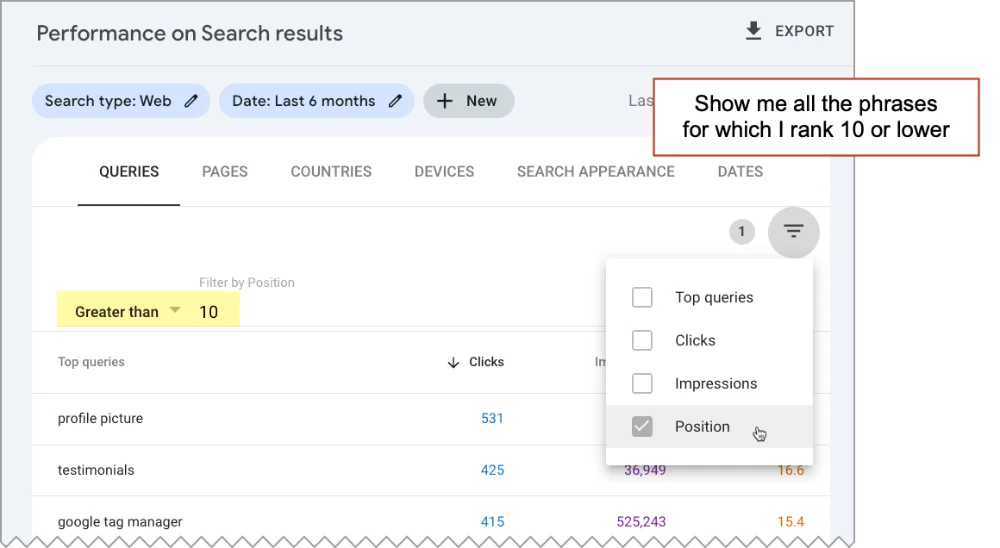
The report will now show you the best SEO opportunities, each of which you can capture by updating that blog post. Google itself is suggesting the keyphrase. You can optimize based on what’s already working.
Caution! Before updating a page, find all the phrases that page ranks for. You need to know if it’s already ranking even higher for other phrases. You don’t want to accidentally de-optimize it by making it less relevant for other high ranking phrases. We’re here to improve quality and rankings, not change keyword targeting.
Update articles that rank well but are starting to slip
Here is your second big SEO opportunity. There are two ways to find them. The first is traffic. Just check changes in traffic over time in GA4. It’s in the Engagement > Landing page report.
Start looking at specific blog posts and it may soon be obvious which ones are in decline.
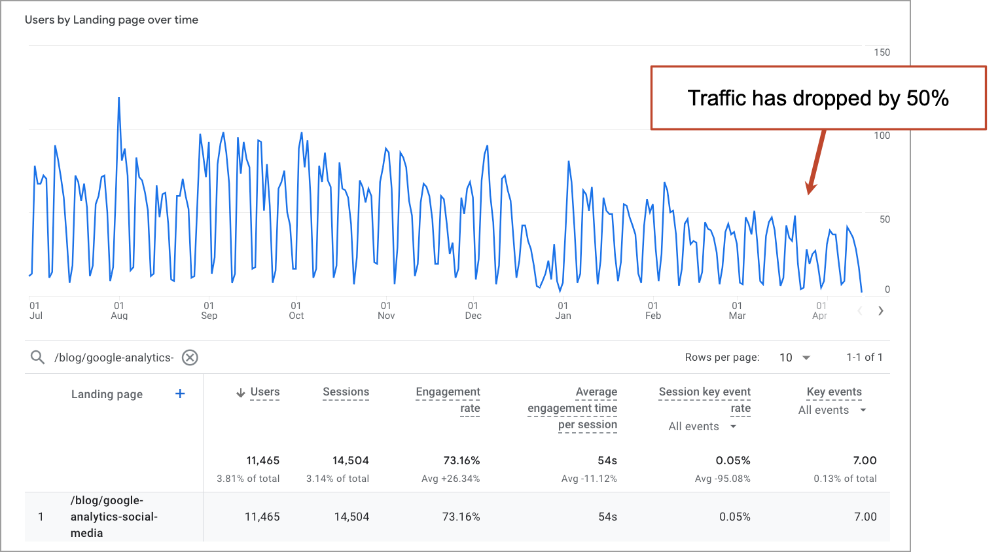
If these are older posts, its likely the traffic is from search. Older articles don’t usually get a lot of love from social media. But to confirm, you can create a filter to show just traffic from search.
Note: It’s possible that traffic has dropped, not because of lower rankings but because of new SERP features in Google, which lower the clickthrough rates to organic listings. This is the biggest trend in SEO and is often the explanation for declining search traffic.
Another way to monitor changes in rankings is with SEO software, such as Semrush or Moz. These aren’t free, but they’ll give you a report that you won’t find in Analytics or Search Console: changes in rankings for specific keywords over time.
Here’s what it looks like:
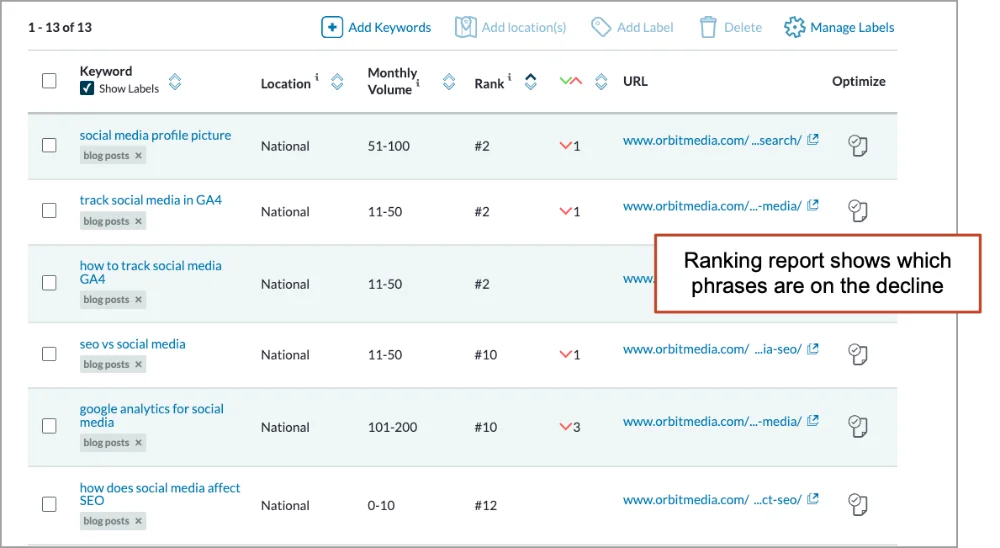
Now that we know exactly which articles need a little love, and which posts to update for SEO impact. It’s time to start improving them.
How to update old blog posts for SEO and higher rankings
There are two approaches to updating blog articles, one small and one big. Some bloggers use a light touch and simply update the headline and a few sections. They include a few new keyphrases, add a few links. Other content marketers go big and actually rewrite the entire post.
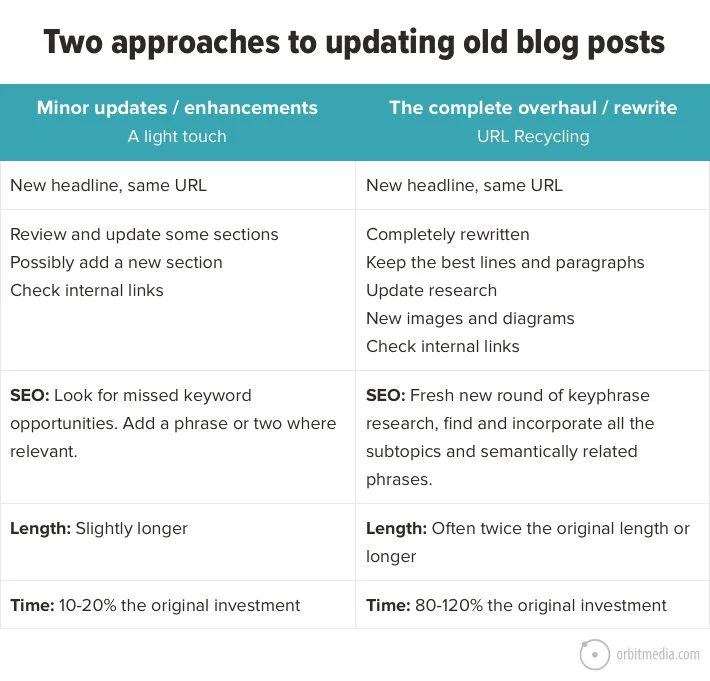
If you have high expectations for results, set high expectations for effort. We recommend that you go big and completely overhaul the article. In content marketing, the 10x efforts are more likely to drive 100x results.
To take the blog post to the next level, we step back and look at the topic again.
- Is there new research on this topic?
- Has your thinking or perspective changed?
- Do you have new examples to include?
- Do you have new articles you can link to? Or link from?
- Do you have new visuals or videos that are relevant to this content?
- Which influencers have current perspectives on this topic? Could you collaborate with them?
In the end, some sentences and sections will be kept. But usually, it’s best to reconsider the topic and rewrite the article. The process for blogging is similar to that of any new article, from researching the keyphrase research to designing the final image. Here’s what our typical process looks like minute-by-minute.
For us, updating content is time intensive. Often the new version takes more time to write than the original. That’s fine. Our goal isn’t to save time. Our goal is to make the best possible article on the topic.
Warning: do not change the URL
Some content marketers are SEOs. Others are not. But you don’t need a lot of SEO skills to understand that Google doesn’t rank websites. It ranks web pages. And changing the URL of a webpage isn’t great for search rankings.
Whenever possible, keep the URL the same. There are two reasons. First, the URL is already indexed by Google. It knows where that content is.
More importantly, by keeping the URL the same, you preserve the value of any links. If that URL has been linked to from other websites, you are leveraging the existing authority of that page, which could be substantial. This is why special steps are needed when redesigning high ranking websites.
To check to see if a page has been linked, go to the Links > External Links report in Google Search Console. It shows you the number of domains that link to every URL on your domain.
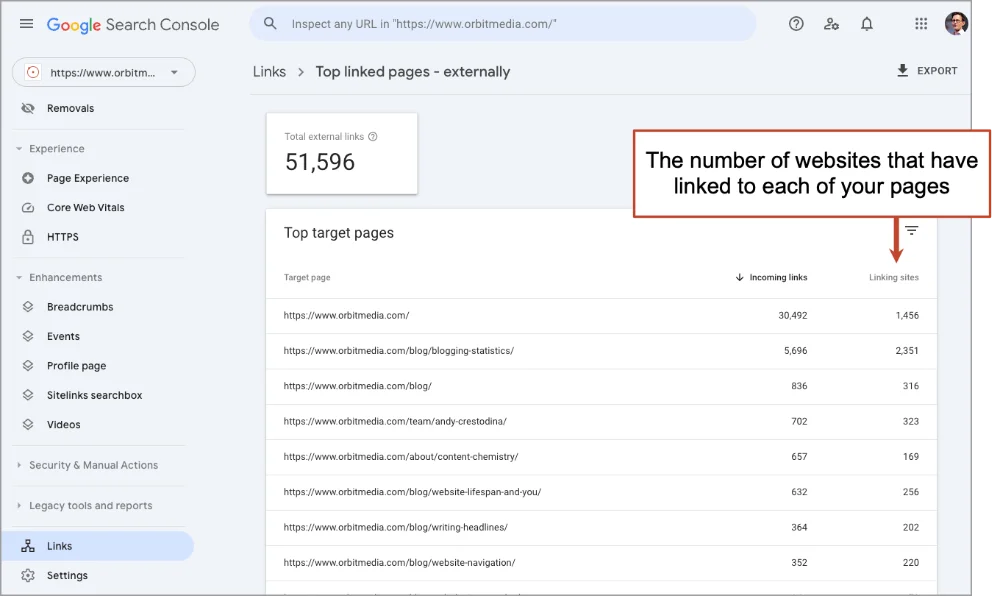
Paid SEO tools have the same report but go one step further. They show the number of links, but they also factor in the quality of each of those links. Together the quantity and quality of links determine the authority of the page. This is its ranking potential.
Here’s what the Moz Top Pages report looks like. The first column is “Page Authority” which estimates Google’s own algorithm for determining the credibility of a URL.
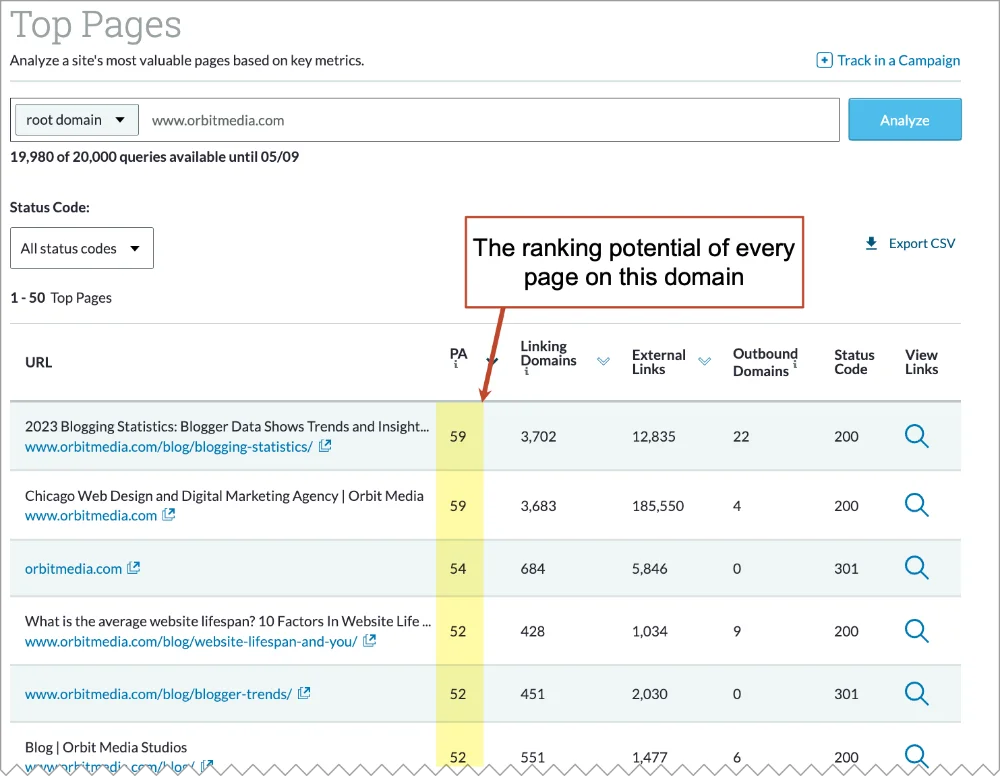
A page has a chance of ranking for a phrase if its Page Authority is in the same range as the other pages that rank for the phrase.
That’s what keyword difficulty is all about. It’s the average Page Authority of the pages that rank for a given keyphrase. Once you understand this simple bit of SEO competitive analysis, you know how to research keywords.
Now the value of preserving URLs is clear. If you create a new URL for the updated blog post, you reset the authority of the page to a lower level.
- When you change the URL, you lose the value of any links. You’re starting over with less authority.
- When you keep the URL the same, benefit from those links. You can target keyphrases that would otherwise be out of reach for a new post. The URL is “pre-authorized” to rank well if it has been linked to by other websites. The foundation is in place to build higher.
With this in mind, there are two-step SEO strategies that are based on attracting links first and writing keyword-focused content later.
- First, publish short-form content that is likely to attract links (infographics, strong opinions, original research). Don’t worry too much about on-page SEO.
- Then, after the URL has attracted links (could be months later) recycle it by writing a long-form keyphrase-focused article at that same address.
Now the page will have both authority and relevance, the two main search ranking factors.
This strategy might be slow (literally a year or more) but allows the SEO to target impossible-to-rank-for phrases. See example #4 below.
URL best practices for SEO and content marketing
Once you understand the value of recycling URLs, you’ll quickly realize that all new URLs should be created with this approach in mind. Make these your new rules for making URLs that are easy to reuse later:
Never put a number in a URL
Example: www.website.com/blog/7-url-best-practices
…that’s bad because when you update it next year, it may have 12 best practices. If you recycle the URL, they’ll be a mismatch with the title and header.
Never put a format in a URL
Example: www.website.com/blog/url-best-practices-infographic
…that’s bad because you may want to publish an article on this URL later. It may not mostly be an infographic (or webinar or ebook) when you update it next year.
Every article’s URL should be short, simple and descriptive. No numbers. No formats. This took us years to realize, but only minutes to teach. Now you know!
How to promote updated blog posts
Rewritten articles have special opportunities that fresh content does not. There are specific content promotion tactics for every channel: search, social, email and influencer marketing.
- SEO: The keyphrase research is already done
You may have selected the article based on keyphrase performance. We showed this process above. You can use that same analysis to do semantic SEO, incorporating all of the related phrases and subtopics into the new piece. - Social: Share with people who shared it last time
Using a paid tool such as Buzzsumo, you can look up the “top shares” of the original version. Scan through, find some good ones, then reach out. Or tag them when you share again.
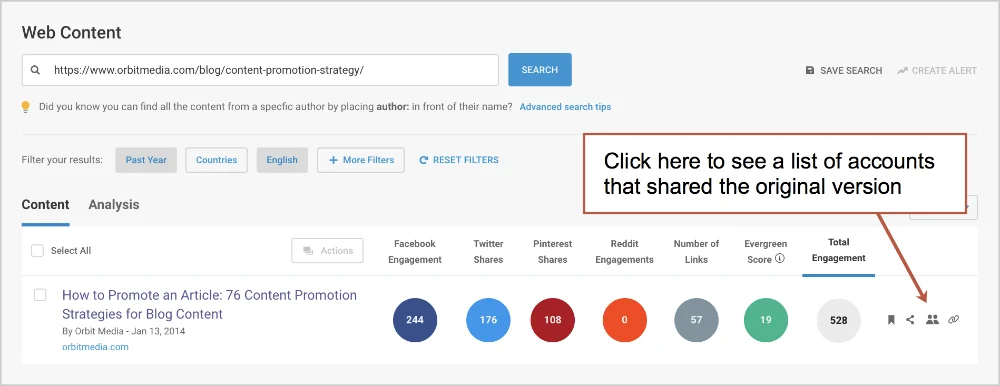
Email: Data-informed subject lines
Social is a high-data, low-engagement channel. Email is a low-data, high-engagement channel.
But you can use social media metrics to guide email marketing decisions. Find the social posts of the article that were engaged with the most (using Buzzsumo or your social media management tool) and then use those words in the email subject line.
Influencer marketing for SEO
Find the articles that have linked to your original blog post (using SEMrush, Moz, Ahrefs.) and then let the author know that your article has been updated. They may cover it again, especially if the new version includes updated research.. This tip is on our list of 29 Ways to Promote Original Research.
Influencer marketing for collaboration
The outreach to influencers is easier the second time around: “This piece was a big hit, so we’ve decided to revisit it…” or “I’m hoping you’ll contribute to an updates to one of our most successful articles…”
Definitely don’t miss the opportunity to collaborate with influencers when updating your content. They can improve the content quality, social reach and backlinks. They also grow your network and make your job a lot more fun. Making friends is the best part of life.
SEO performance of updated blog posts: 5 examples
In the examples here, I’ll show you the fruits of the labor.
Each is like a little story with ups and downs. We’ve added screenshots of ranking reports so you can see the change in rankings for each SEO update. We also show Google Analytics performance, using Universal Analytics to show historical data and GA4 when possible.
1. “Nevergreen Content” Timeless topic, updated continuously
The idea of “evergreen content” is that it never goes out of date. There is debate about whether any topics are truly evergreen. Scan through the comments on this YouTube video and you’ll see. Passions run high.
But if the topic isn’t going out of style, it might be a good SEO opportunity. But you have to commit to the content and keep it updated. Never give up. If you keep rewriting it, that’s “nevergreen content.” A good example is the Sprout Social Always Up-To-Date Guide to Social Media Image Sizes.
In 2013, we wrote an article explaining website traffic sources. We tracked the keyphrase, but it didn’t rank well. But we didn’t give up. Five years later, we updated it with tons of fresh details and a video. It soon climbed to the top spot in Google.
When the rankings started to decline, we doubled down again in 2020 adding tons more information, diagrams and more video. Then again in 2023. Here you can see the size and shape of the article over time. Scan through the current version to see just how the content has grown.
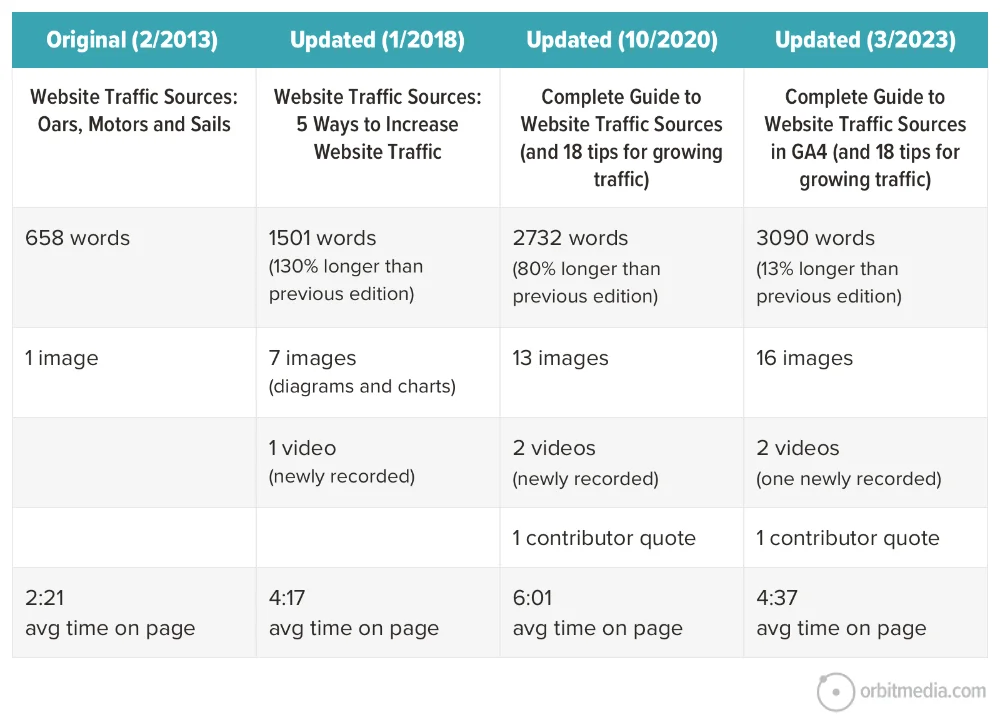
What about the search performance? Here you can see the impact of the rewrites on rankings and search traffic.
Alas, competition for this phrase may be too fierce for a tiny marketing team like ours to hold onto the top spot. But the efforts have been worthwhile. 10,000 visits total. Also, it’s attracted links from dozens of websites.
2. “Write first, research keywords later” rank then rewrite
When this article was first written, it wasn’t focused on a single topic. It covered several topics. So it wasn’t really keyword focused.
But when we checked the rankings months later, we noticed that it appeared in search for the phrase “semantic SEO.” This was one of the topics covered, but it wasn’t the focus of the article. It was an accidental ranking, which is very common in content marketing.
But every accidental ranking is an SEO opportunity. You just need to rewrite the article and sharpen the focus on that topic and keyphrase. The key is to check the rankings and let the current keyword performance guide the SEO updates.
Let Google do the keyword research for you.
Keyword research is hard. Checking rankings is easy. You can look up the rankings for any URL using Google Search Console or your favorite SEO tool.
The article was rewritten. The new keyphrase was added to the title and header. A video was added. Within weeks it was ranking high. It attracted 15,000 visitors from search over the next six years, then the rankings started to fall. So we rewrote it again and the rankings recovered.
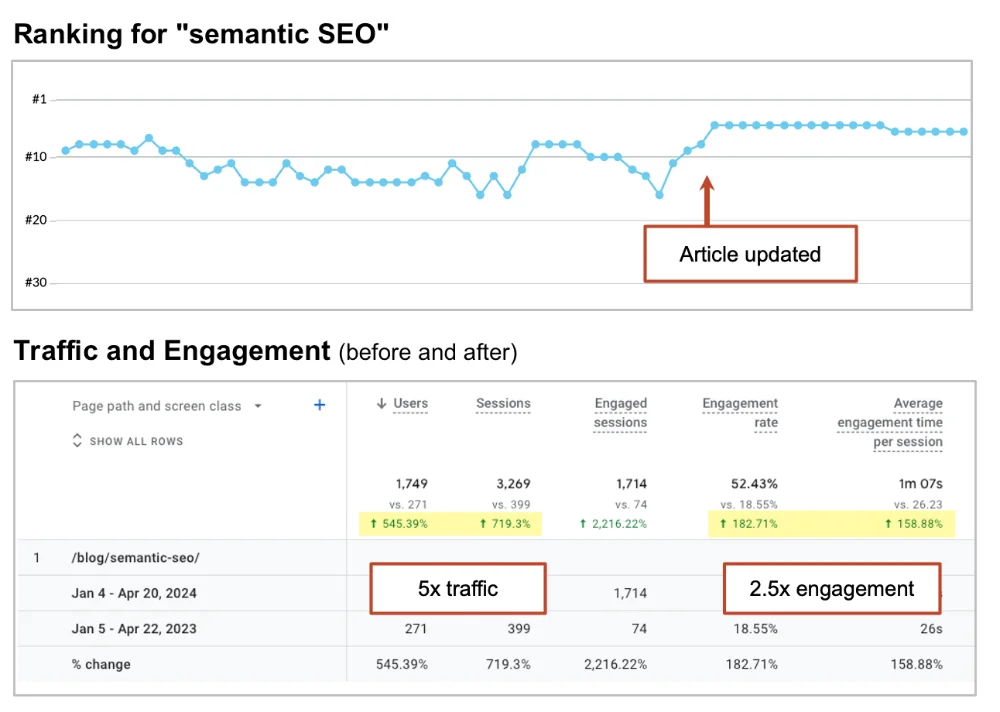
In this example, I’m in GA4 showing the change to engagement rate before and after. Visitors were much more engaged with the new version. Quarterly traffic was up 700% and the engagement rate was up 180%. People like the updates.
Why? Because it’s more comprehensive. That’s what search engines and humans want.
Compare the updated blog posts to past versions. The word count isn’t the only change. The later versions were much more robust. We used every item on our 22-point web content checklist.
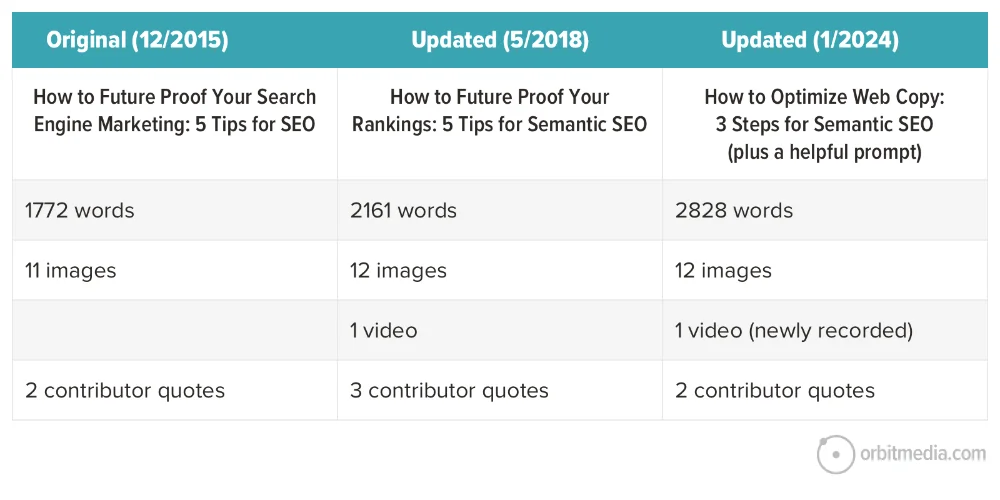
3. “Byline takeover” Rewriting an old guest post
Back in April 2013, a friend wrote an article for us about the basics of SEO. A few weeks later, I noticed that it was ranking for “SEO basics” so I started tracking the phrase.
Over the next few years, we watched the rankings slide into oblivion. The content went out-of-date, new competitors for the phrase appeared, Google moved on.
It went from 200+ visits per month to less than 20. Rather than leave it there in the abyss (or asking my friend to go write it again) I wrote a new post on the same URL.
The new post went live in 2018. Almost immediately the rankings recovered as did the traffic. It’s ranked on page one ever since …although it’s since starting to slide again.
Here you can see the SEO and traffic results. I’ve overlaid the rankings with the pageviews so you can see the correlation. To see the historic performance, I’m using Universal Analytics, which stopped recording traffic back in July of 2023.
I ranked well for the first two years after it was first published, then rankings and traffic declined. Then it was rewritten, which caused a huge and immediate impact on rankings and traffic. Then four years later, it slides off of page one again.
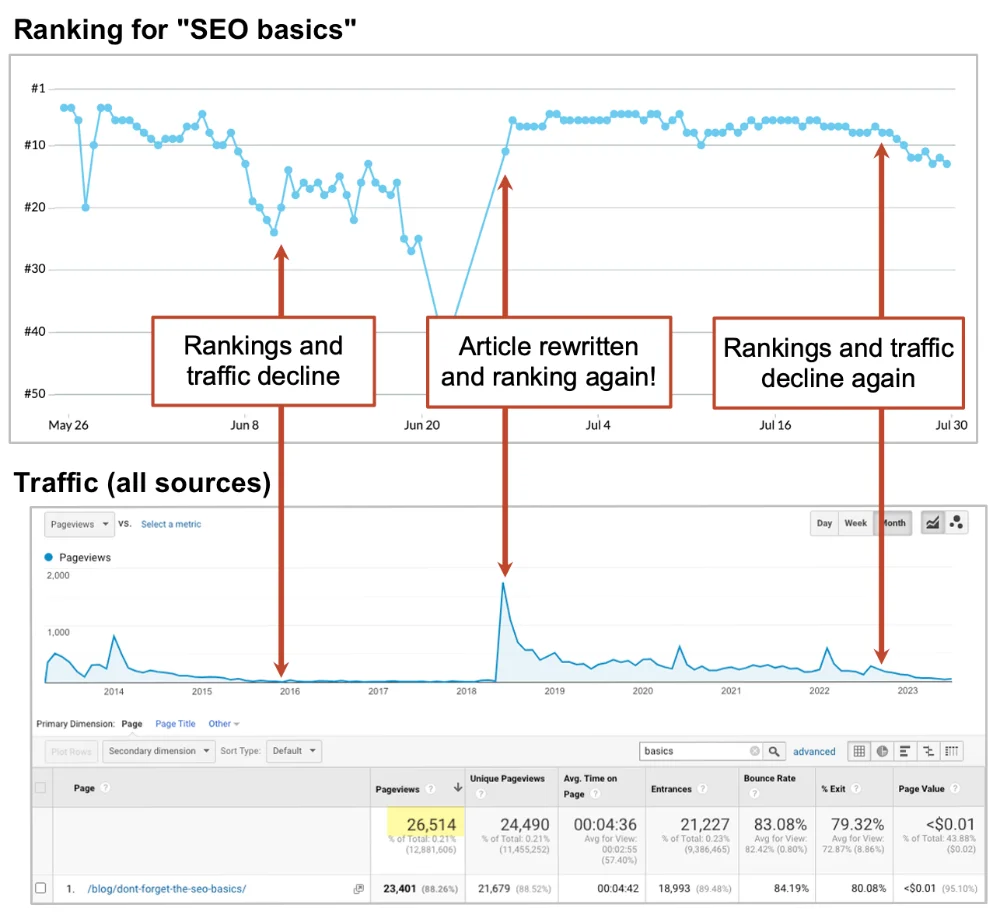
The URL has been viewed 26,000+ times over the years. Most of that traffic is from search. But to have any hope of recovering the previous levels of visibility, we need to update that blog post for SEO again.
And here’s the before and after for the content and engagement. The updated article has more depth, visuals and points of view. I
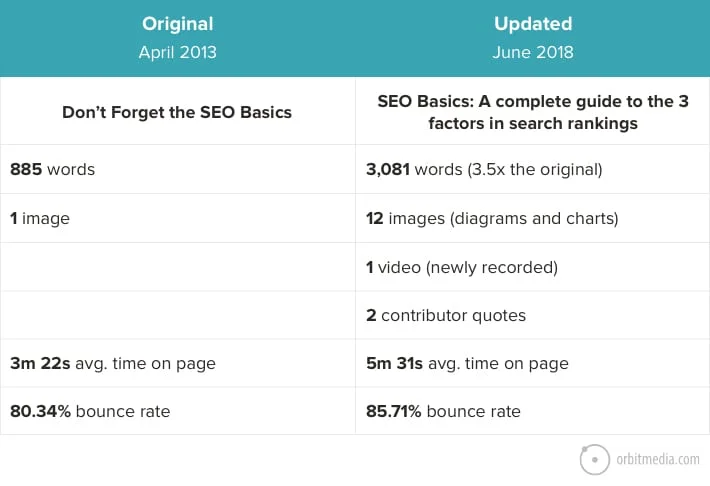
Bonus! I recorded a video version of me presenting the content and added it to the top of the post. This is part of our YouTube content strategy and that video has attracted 4,100+ views.
The byline takeover works the other way too. When our 2015 article about social media automation went out of date (and rankings dropped) we reached out to our friends at CoSchedule. Ben Sailer rewrote it on the recycled URL and rankings recovered for the next year. Thanks, Ben!
4. “Second chances” how to win for an impossible phrase
I remember that afternoon clearly. I was doing keyphrase research, checking competition for a new article. I saw the data and thought to myself “I have no chance for this keyphrase.” I was right. I had no chance.
But the high ranking pages were written by the content marketing greats. My heroes, actually. Their content was deep, concise and practical. Their articles all had lots of links and high Page Authority.
But there’s more to life than search, right? I wrote the article anyway. It’s an excellent guide that explains how to write headlines. It’s an important topic that I felt strongly about. I’d written hundreds of headlines and I wanted to share what I’d learned.
Even though the phrase was out of reach, I optimized the post for “how to write headlines” by simply incorporating it into the title, header, body text and URL. It went live in September 2014.
It didn’t rank. No surprise.
But I kept promoting the article for years.
- I mentioned it in presentations
- We kept it in social media rotation
- I wrote guest posts on the topic and references the article
- I talked about it on podcasts
- I referenced the diagram from the post in contributor quotes whenever possible
Referencing images in contributions is one powerful example of how images can affect SEO. Here’s the diagram from that post. It explains what happened anytime a human sees a headline. Nice right?
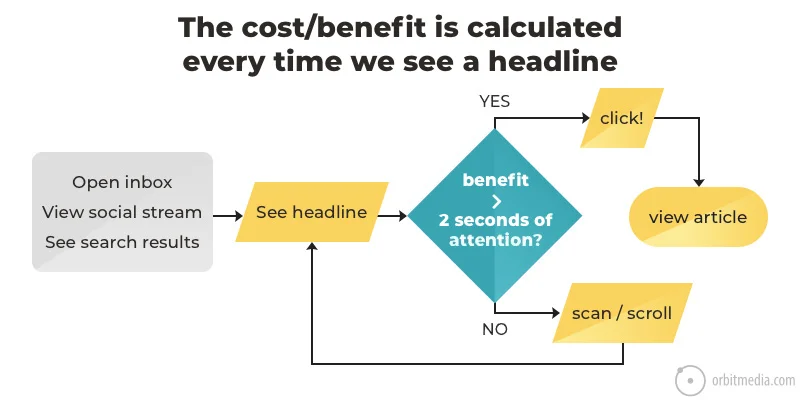
Eventually, the article began to age. Over time, we found new research, we had new ideas and we earned more experience writing another 1000+ headlines. So in May 2019 we updated the article.
But this time, the URL had an advantage. 100+ linking domains gave it a Page Authority of 45. That target keyphrase didn’t seem so out of reach this time around.
The rewrite wasn’t longer, but it definitely was more complete. We recorded a video for it, added those diagrams and collected new contributor quotes.
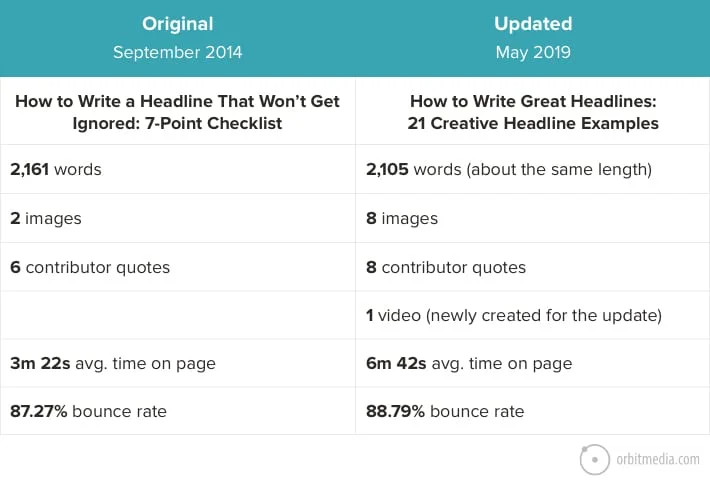
The results? The average time on page doubled. And it now consistently ranks at the bottom of page one of Google. We are thrilled.
Here are the rankings and traffic together. The 200+ visits per month might not seem like much, but it’s an honor to rank among the other great articles on the topic.
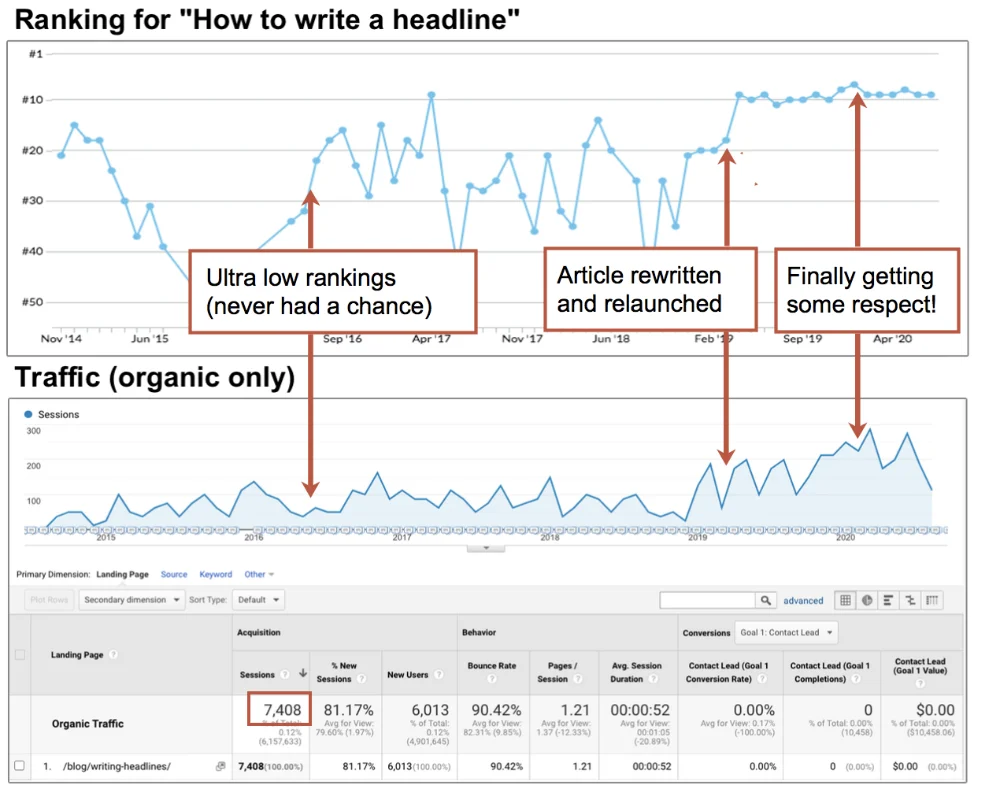
Since the rewrite, the post has started attracting more links, probably because it’s now more visible. Each link improves its ranking potential, while also strengthening the authority of our entire domain.
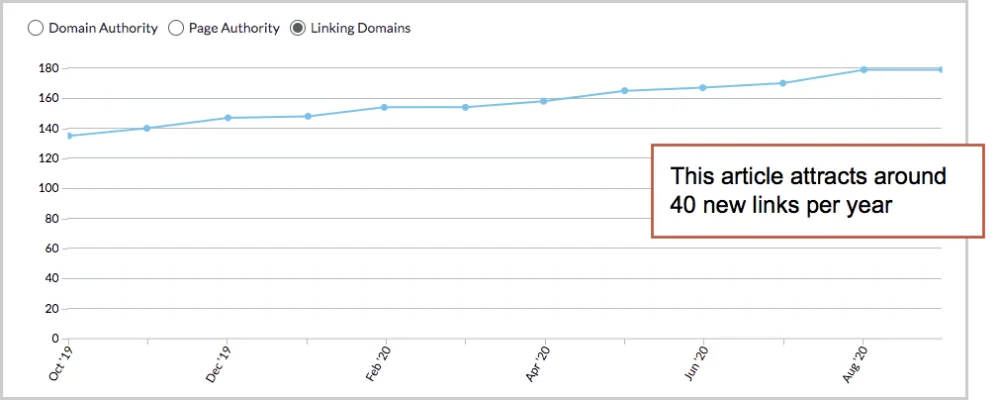
…and we’re not done yet. Maybe the next version will crack the top five search results. Never give up! 🙌
5. “Never surrender” …write, rewrite then rewrite again
In June 2012, we published an article with tips for promoting content. Keyphrase research quickly showed that “content promotion” was a very competitive phrase, so I used the longer, less competitive phrase in the title, header and URL “content promotion strategies”
It actually ranked well for both phrases, attracting 150-250 visits per month. But the rankings gradually declined and it got very little traffic for several years. So I finally sat down and rewrote it in August 2016, adding all of the content promotion tricks I’d learned since 2012.
The headline changed from “33 ways to promote content” to “50 ways to drive traffic” and the rankings and traffic soared. So did the average time on page (see below).
The article enjoyed three years of high rankings and 300-500 visits per month, always performing a bit better for the longer, less competitive phrase. But eventually, new (and better) articles were written and began to push both rankings down.
But we didn’t give up.
We re-rewrote it in May 2020, this time adding more tactics and more depth. This post is now 76 ways to promote content (did I miss anything?) and the rankings have partly recovered. Here’s the timeline of rankings and traffic since 2012.
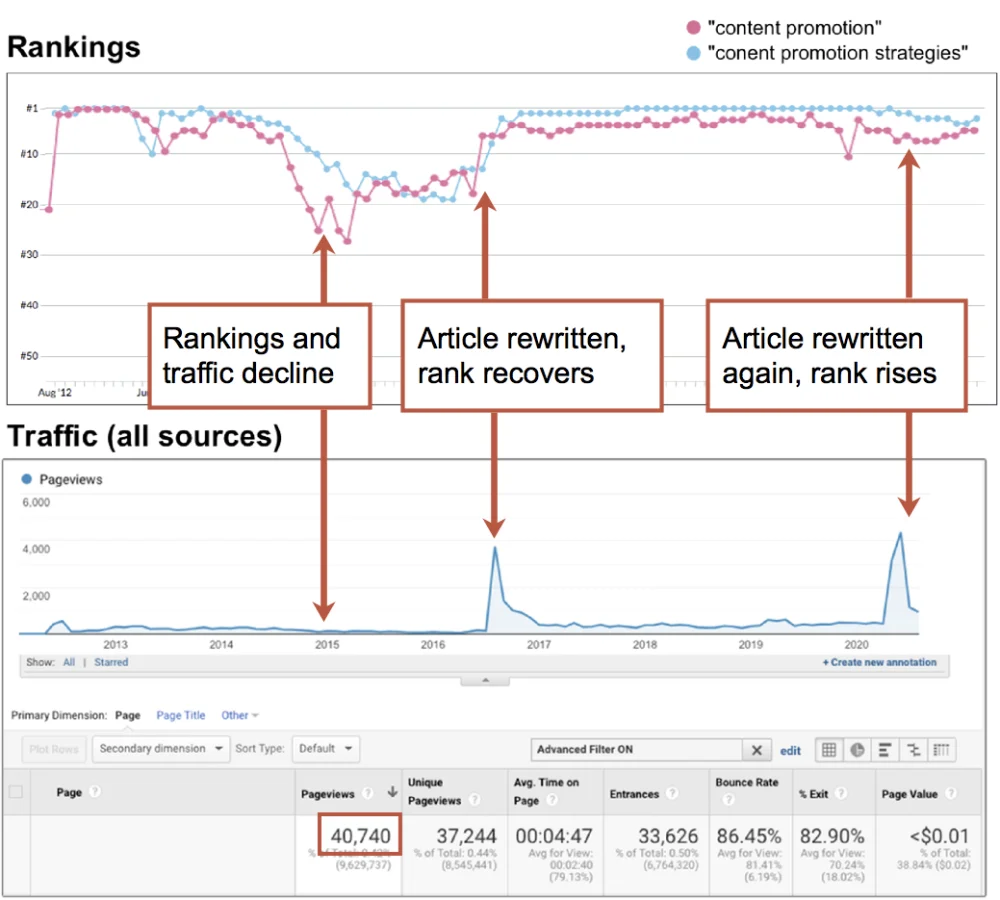
And here you can see the evolution of the article with the headlines, length and assets. Again, we’re showing a few behavior metrics so you can see how the content attributes correlate with engagement.
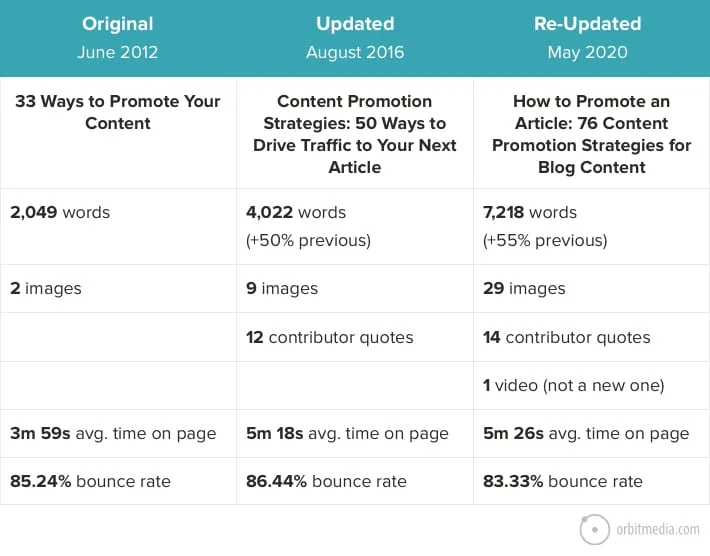
You don’t need 1000 articles.
You need 100 great articles.
Since 2016, when we first discovered the value of updating content for SEO, it’s become central to our content strategy. Currently, about half of our articles are actually rewrites of older articles.
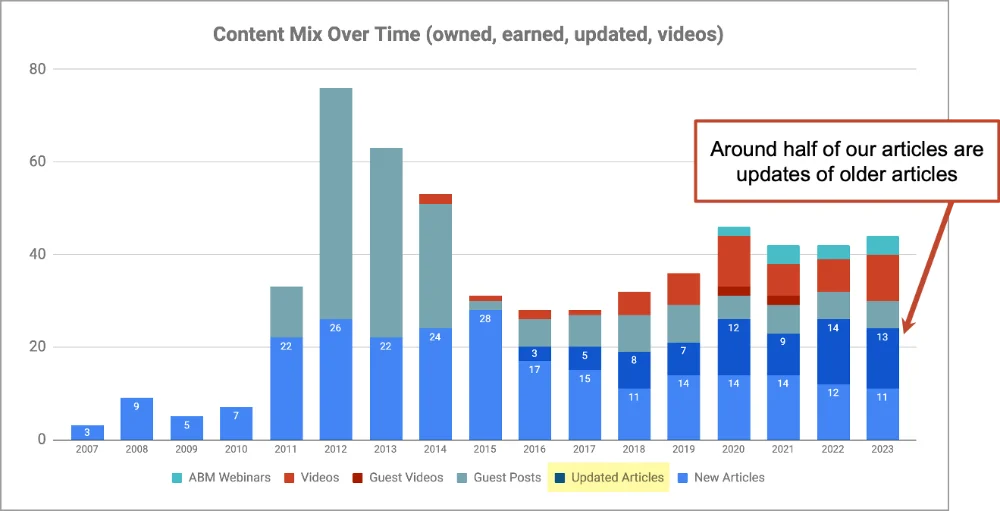
In fact, the article you’re reading now was originally published in 2016, then rewritten in 2020 and now rewritten again here in 2024. It gets better every time. This will give you a sense of our commitment to our content:
- 50+ posts on the Orbit blog have been rewritten once
- 15 of our blog posts have been rewritten three or more times
- Our annual blogger research is in its 10th year and it’s always published on the same URL
- Several other research pieces get updated annually (the Spam Report, the AI Readiness Survey)
- Our book, Content Chemistry, is in its sixth edition (v7 is coming soon!)
Commit to keeping content current
Of course, it’s important to publish articles and put new URLs and keywords into the world.
But you’ll get faster results by going back and keep those top performers updated. You’ll capture more search volume from the same phrases with less effort.
 |
Aaron Orendorff, Head of Marketing, Recart“There are two ways to breathe new life into old posts. First, use the old post as a base and create a fresh, stand-alone article. I did this recently for my most popular post on Content Marketing Institute: from the original with 2k words and 11 points to the update with 4k words, 19 points, and a downloadable PDF. Second, simply update your old posts themselves and keep the original URL. We’ve done this at CTC for a host of articles, including the incredibly competitive keywords “ecommerce trends.” Originally published in Feb. of this year, it was updated with fresh data and insights at the end of Aug. The results — via SEMrush — speak for themselves.”
|
Here are a few final considerations…
- If your blog post doesn’t rank, maybe that’s because you’ve only written it once.
This is what the search engines want you to do: create an amazing piece of content. - If your content is search optimized, you’ve basically committed to this strategy already.
Your search optimized content has durable visibility. People are still reading it. Don’t let them down. Especially if you don’t have dates in your blog template (we don’t) - If you’re about to write a new article, first look to see if you can recycle an old URL.
If it’s a URL that has been linked to, it will have a natural advantage in search.
Now go teach your old blog new tricks!




